It’s always wise to make an informed decision on what types of plants you can plant in close proximity to your house. Making the wrong choice can cost you dearly in years to come.
When we select plants for planting close to the house these are the things we are looking for:
- Small to medium in height
- Roots that are not invasive
- Soft foliage
- Interesting year round
- Easy to care for
Below is a list of 16 plants we have planted right up close to our house.
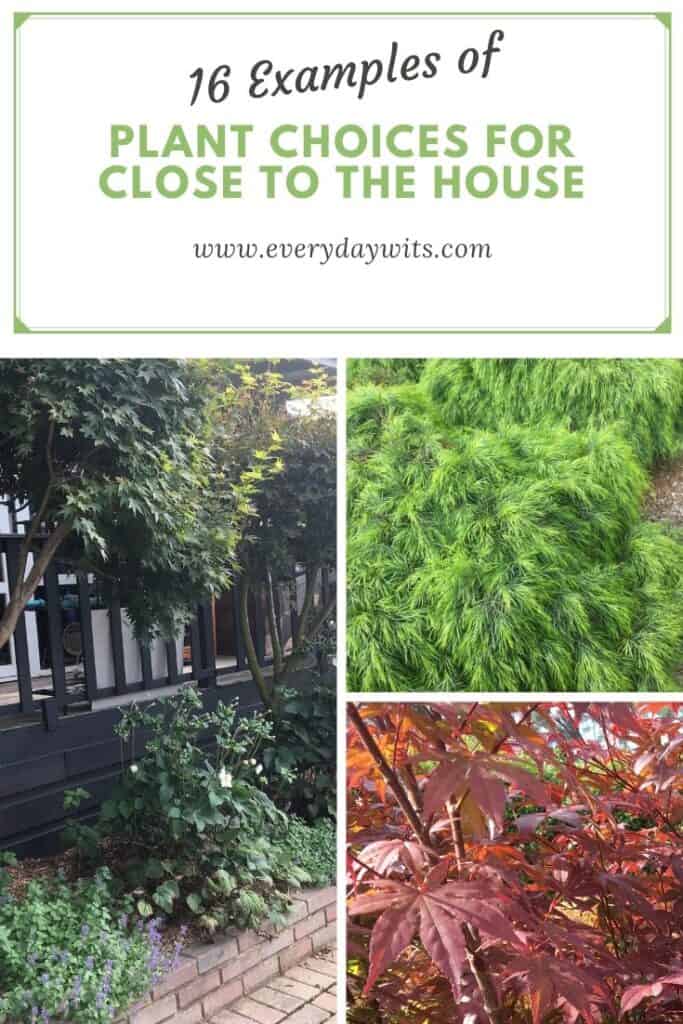
I like to keep anything near the house smaller than the height of the gutters. This helps reduce the frequency i need to clean them out.
Invasive roots can cause all kinds of problems with the houses foundations and the pipework around the perimeter of the house. We avoid plants with invasive roots near a house at all costs!
Being close to the house we prefer soft foliaged plants. Areas close to the house have constant foot traffic as we go off to work, pick up the kids, bring home the shopping etc. We are forever brushing up against the plants around the house. For this reason no roses close to the house…Ever!
The plants around the house can make or break your curb appeal. Selecting plants that are interesting for most of the year is really important to us. On this list i have some deciduous varieties but if mixed with the right companion plants you can still create year round interest.
I love my gardens but I’m a lazy gardener. I want to enjoy the garden not always be toiling in the garden. For that reason all the plants on my list are easy to care for.
Keep in mind that this list is by no means the only plants you can plant close to your house. There are literally thousands. This is just to give you some ideas. Every plant on this list we personally have in our gardens..
Read to the end of the article for some handy tips on how to stagger your plantings.
Hydrangea
There are two types of hydrangeas we have near the house the first is the common variety (hydrangea macrophylla) which is available in various flower colours: red, white, pink, purple and blue.
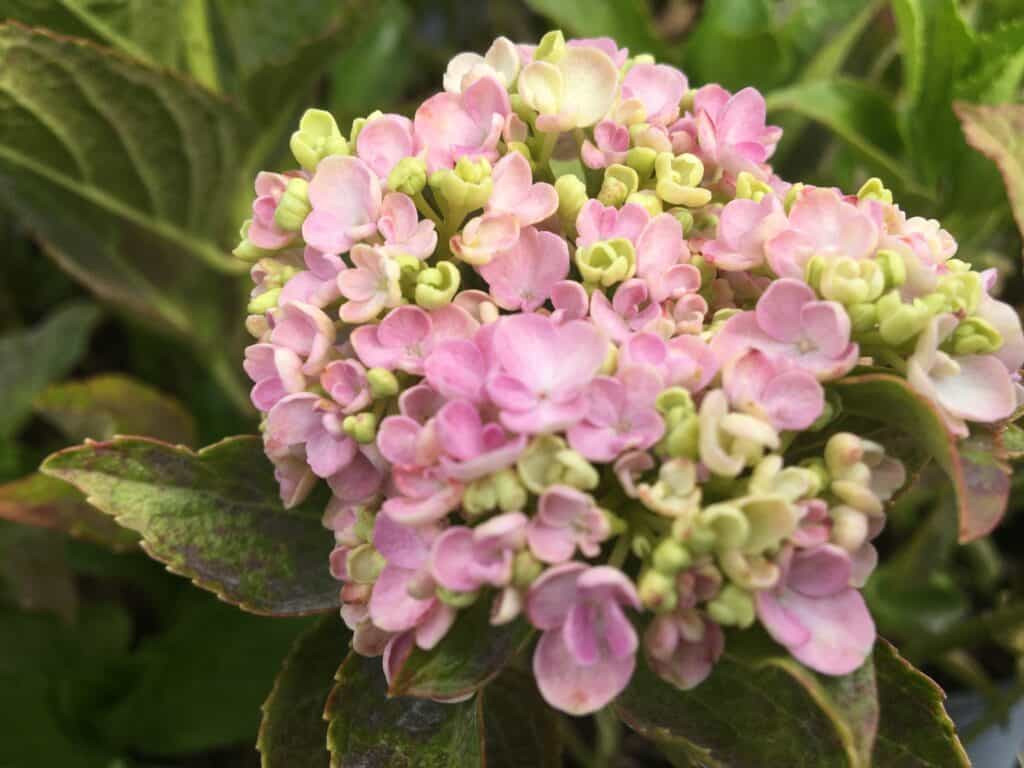
The pink, blue and purple variations are actually the same plant, which colour it flowers as will be determined by the pH of your soil.
The second species of hydrangea we like to plant close to the house is oak leaf hydrangea (hydrangea quercifolia) this has interesting foliage and a white flower.
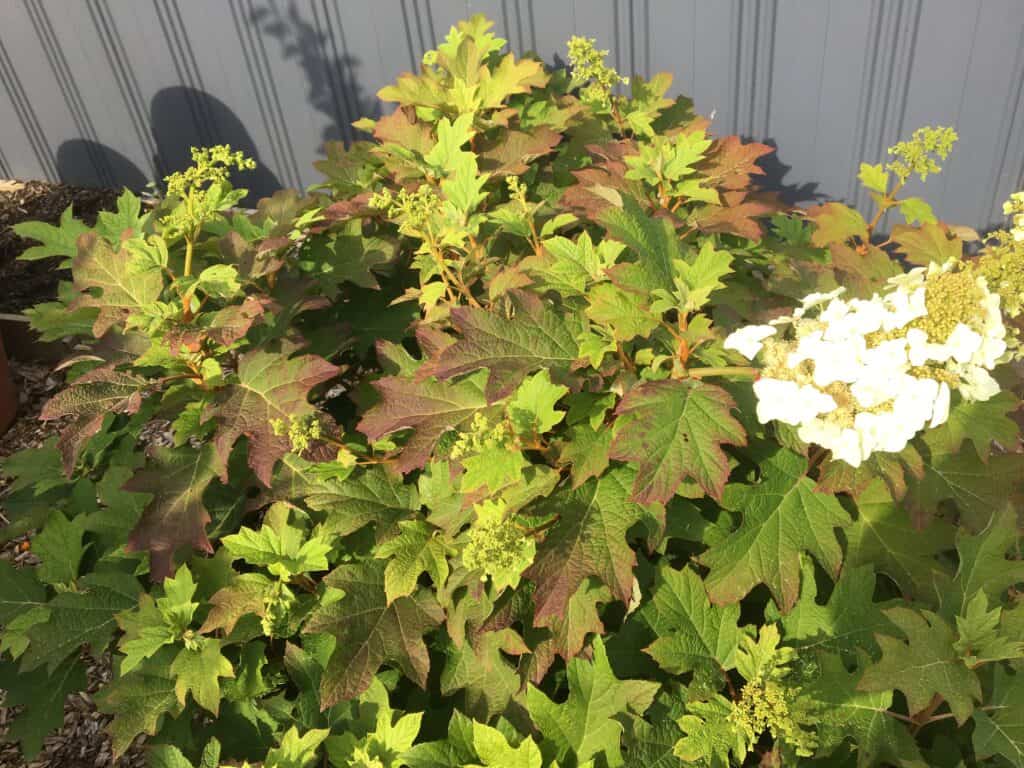
Both varieties flower in mass during summer. They are deciduous so over winter they will drop their leaves. This is fine as we can incorporate plants that provide winter interest in close proximity to the hydrangeas.
Hydrangeas are a medium sized shrub with a higher and spread of 1m2. Being deciduous makes pruning vary easy once the leaves have dropped.
Each winter we prune out some of the old branches to maintain good airflow for the following season. Hydrangeas can be prone to mildew if the foliage is wet for extended periods of time during warm weather. Providing good airflow allows the foliage to dry easier.
Hydrangeas should be planted in areas that area semi shaded particularly from afternoon sun. They do best in heavier souls that retain moisture. They can be grown in sandy, well drained soils but will need regular watering seeds during summer.
The root system on hydrangeas isn’t invasive, the flowers are spectacular and the foliage interesting. A great choice for planting close to most houses.
Clivia
Clivias are one of my personal favourite plants ever! Specifically clivia minata. They have strappy glossy green leaves and very colourful flowers (red, yellows, pinks and white). Best of all the thrive in deep, dry shade where it can be incredibly difficult to find plants to grow let alone thrive.
They are a slow growing plant and require practically no maintenance. Every 5 years you can divide the clumps if you feel the need to thin them out.
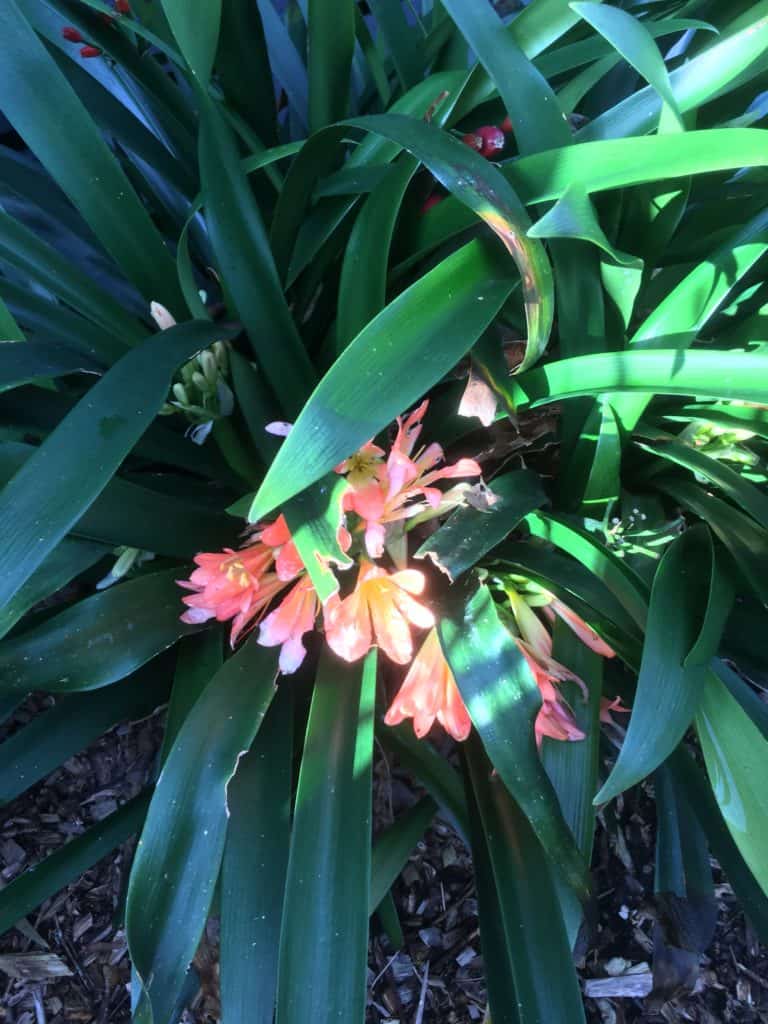
Clivias will need protection from frosts so may not be suitable in all climates. They will tolerate many different soil types from sand to clay and anything in-between. Provided they have shade and frost protection they are bullet proof.
The flowers appear in late winter and early spring. When flowering they look truly spectacular! After flowering the flower stems will develop small berries, these are the seed pods. You can leave these berries on as they will colour up into the same as the flowers and look quite attractive.
On the shaded side of our house we have planted camellias with the clivias underneath. Throughout winter and into spring that side of the house displays an abundance of colour. During the remainder of the year i enjoy the deep green foliages.
I feel instantly cooler in this garden during hot summers. Because these plants are planted up close to the house it keeps the verandah nice and cool. Quite often I’ll find the cats and dog sprawled out in this area getting some much needed respite.
Hellebore
Helleborus orientalis commonly known as winter rose is a great little filler plant that will provide pops of colour throughout the winter months.
It works well planted in the same vicinity as hydrangeas. This way when the hydrangeas are dormant the hellebores will pick up the slack and put on a show.
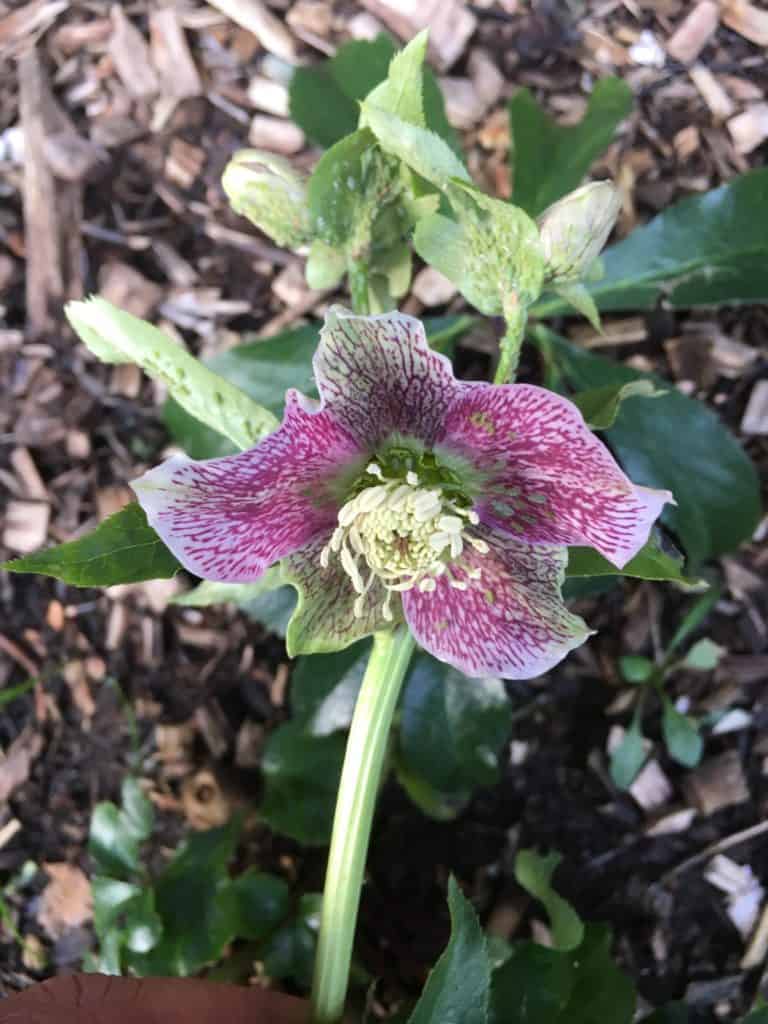
Planting them amongst deciduous shrubs will also protect them when the weather warms up. The foliage can be prone to burning if exposed to too much sun.
Helleborus need almost no maintenance. After flowering you can prune them down to ground level if desired. Otherwise as we like to do allow them to self seed and they will naturalise and fill in any gaps in the understory.
Japanese maple
The botanical name acer palmatum is attached to the many different cultivars of Japanese maple that are commercially available. Some people may think that these are too big to plant close to the house. But there is sooooo much variety in shapes, sizes and colour that you can find a Japanese maple for any situation.
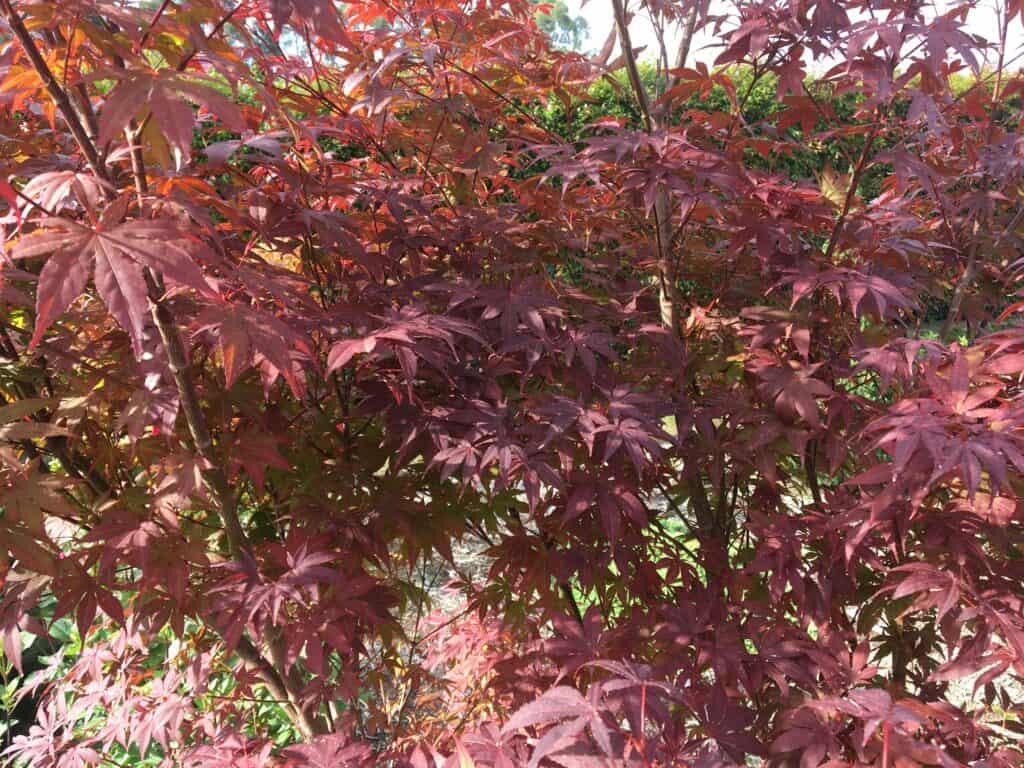
Most Japanese maples have a compact root system so pose no threat planted close to the house. They are deciduous so can easily be pruned during the winter months when there is no foliage. We prune ours every winter to keep them below the roof gutters.
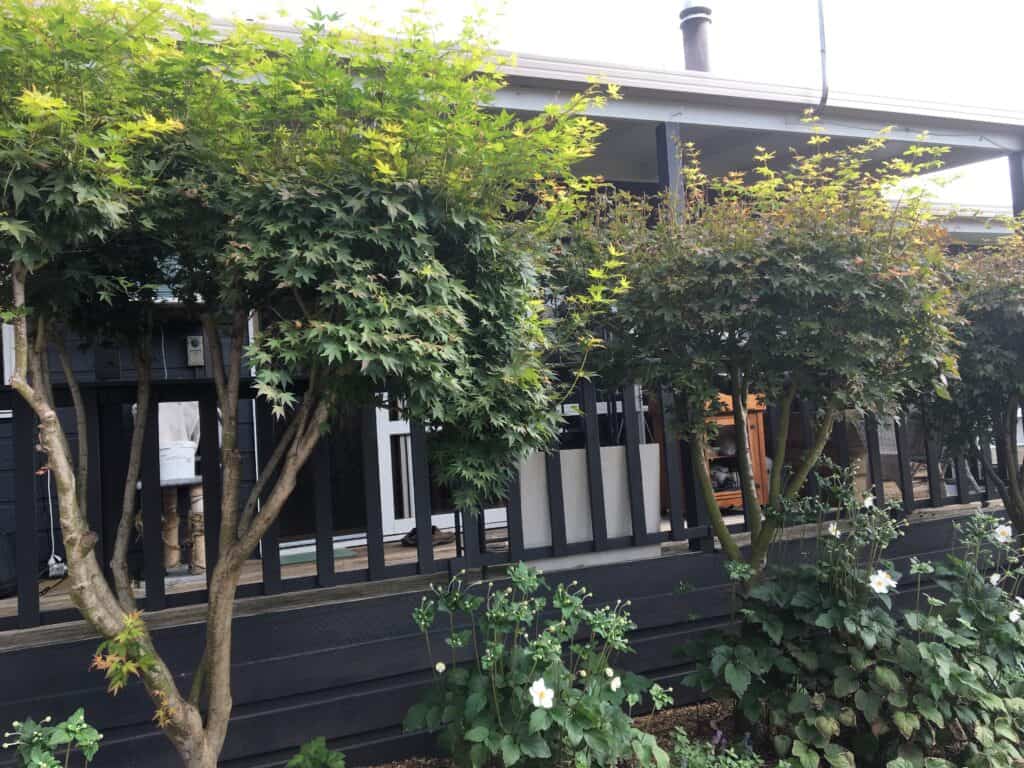
Maples are renowned for their brilliant autumn colours, yet the soft colourful foliage i find interesting throughout the growing season.
You can select weeping varieties that are grafted onto upright stems. This way you’ll know exactly what height the maple will grow too, if thats a concern. Overtime the head of the maple will fill out.
Japanese maples do need some protection from hot summer winds. They will grow quicker if you provide regular water throughout spring and autumn.
Camellia
Camellia’s are another great small tree that can be planted close to the house. We most commonly plant camellia sasanqua varieties but occasionally use camellia japonica.
Camellia sasanquas are faster growing and more hardy. Camellia japonicas are slower growing need some protection from intense sun, but provide bigger flowers.
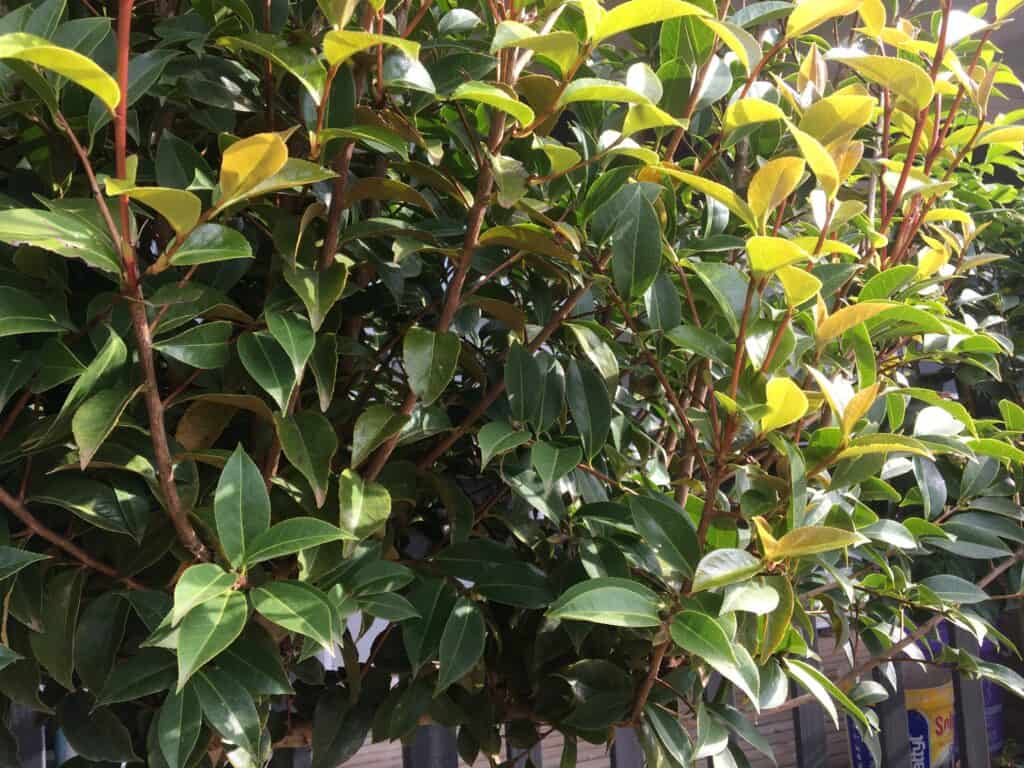
I love that camellias are evergreen, provide a burst of colour through the drab winter months and can handle a good pruning anytime of year. Even if you’re like me and a bit heavy handed with a pair of shears in your hand.
Camellias can be used to provide some height close to the house or even a privacy hedge. Camellia sasanqua varieties make the best hedges.
We’ve found camellia’s to be a very undemanding pant apart from a quick prune once a year.
Anemone
Anemones commonly called windflower are another good filler plant. Throughout the warmer months of the year they have attractive foliage. In late summer and through autumn they provided beautiful flowers. We like anemone x hybrida theseare available in whites and pinks.
Anemones will spread and fill in empty gaps. We like our gardens full with different sized plants as this will keep weeds suppressed giving us more time enjoying the garden and less time weeding!
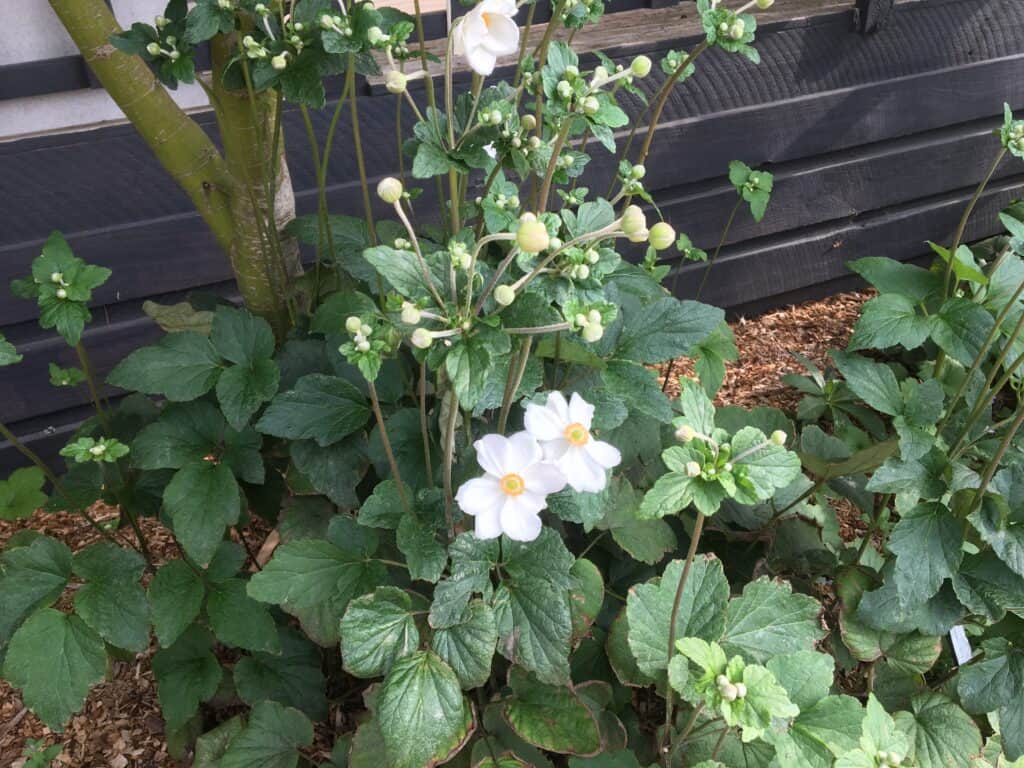
Windflowers are easy to care for. They are best positioned in a partly shaded area. Anemones will take a couple of years to really establish but then they really take off, so don’t fret if they appear to do nothing in the first two years.
The flowers appear on stalks up to a metre high. Avoid planting in deep shade as the flower stalks will stretch in search of light and become weak. Adding anemones under Japanese maples just enhances any fall garden.
Gaura
For those looking for a splash of colour throughout the majority of the year, look no further than gaura lindheimeri. Gauras are available in pink, white and yellow. My personal favourites are the pink forms.
From spring to autumn these little beauties just keep flowering. Bees love em! One of the common names for gaura is bees blossom.
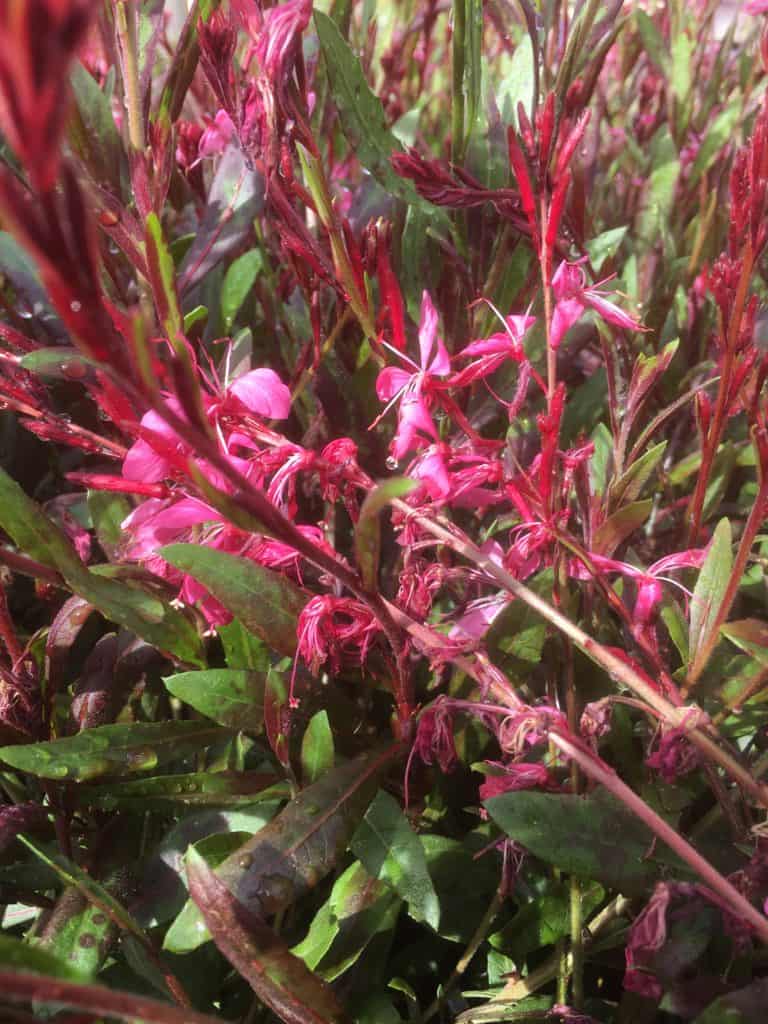
Gauras prefer full sun and are incredibly hardy once established. They are perfect for planting near the entrance to the house where their constant supply of flowers will wow your visitors, and enhance your curb appeal.
Caring for gauras is simple and anyone who is heavy handed with shears will love this next part. Whenever they plant looks a bit past its prime take to it with a pear of sharp shears, cut it down to a couple of inches above ground level. In 3-4 weeks the plant will be blooming in force once again.
Sedum
The common name for sedums is stonecrop. They are a hardy succulent plant that are perfect for those hot, sunny, exposed areas close to the house. Pretty much all are ground covers.
Our personal favourite is sedum mexicanum “gold mound’. It has striking lime green to yellow foliage. We have found it to be frost tolerant which is important where we live in Gippsland.
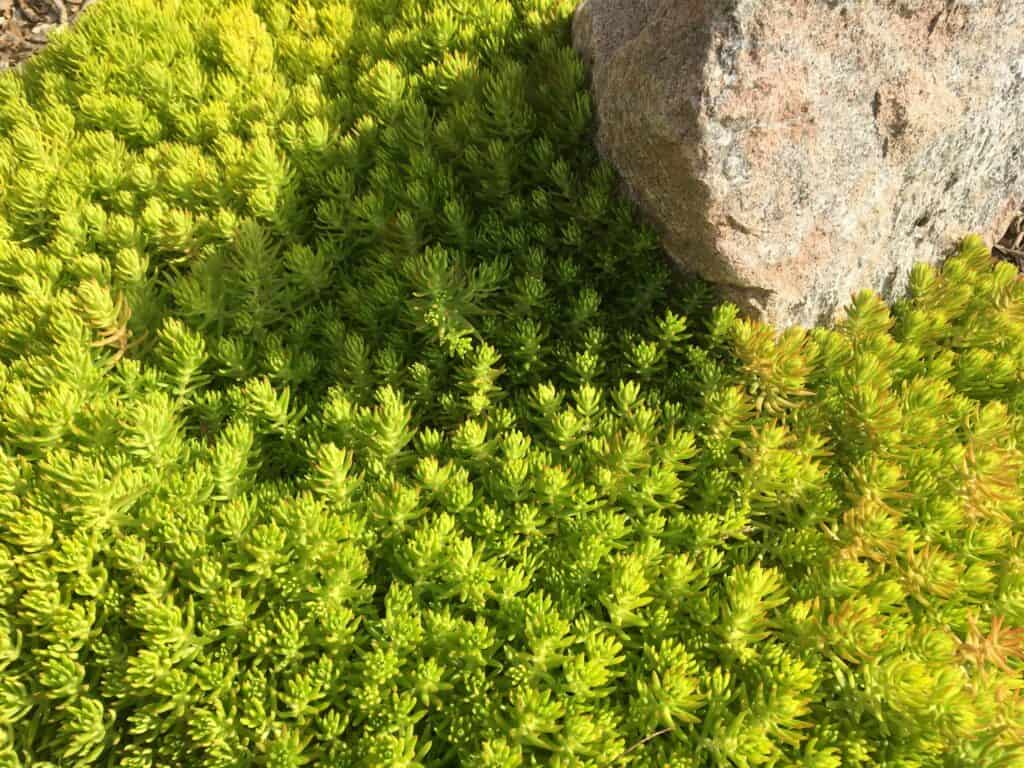
Sedums are one of the easiest plants to grow and will thrive on neglect. We have incorporated them in the garden near our living room window which is exposed to very hot direct sun, throughout summer.
Mixing sedums with other taller growing succulents can provide an incredible display of colours and interesting shapes.
Scleranthus
Scleranthus is a really cool plant but I’m not sure how popular it is outside of Australia. It’s a small mound forming ground cover that looks like a green cushion or a little mound of moss.
The variety we grow is scleranthus biflorus commonly called Canberra grass. It’s native to the alpine areas of eastern Australia. In its natural environment it likes gritty well drained soil. Ours are growing in clay and thriving.
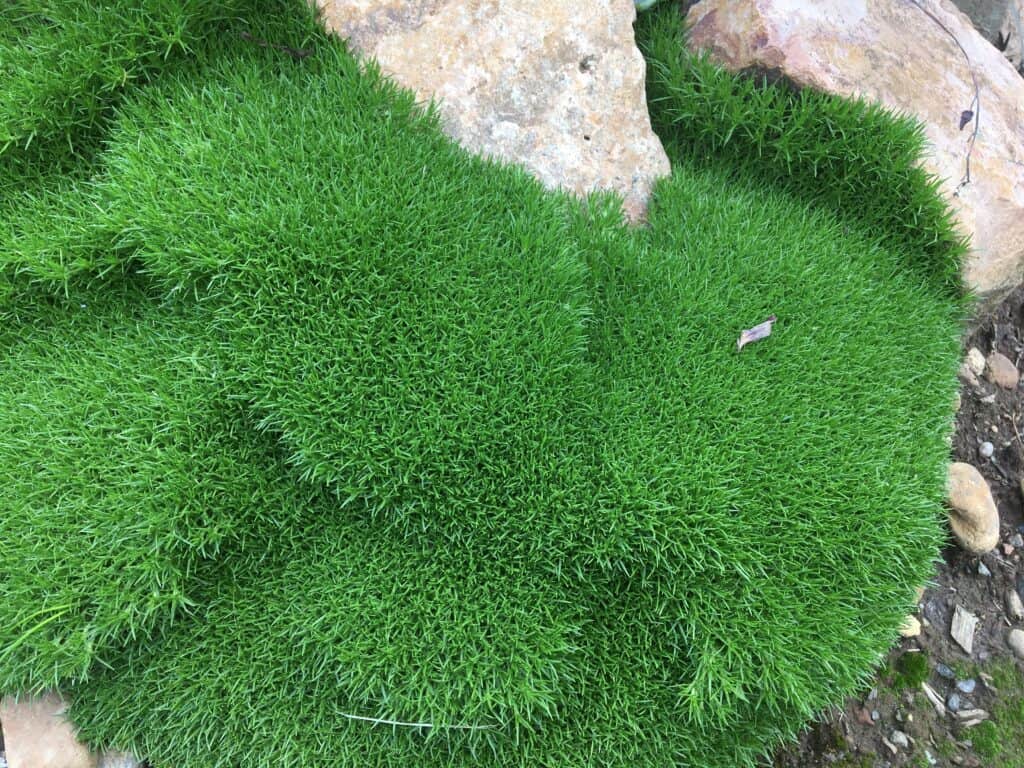
Scleranthus is unfazed by frost but will require a good watering on very hot summer days. Other than that it’s very much a set and forget plant.
Ive added around one of the ponds we have next to the house. It also looks awesome in dry creek beds and rock gardens.
Heuchera
Heuchra species commonly called coral bells are fast becoming one of my favourite plants. When we created a new garden at the front of the house we added some as an edging. It was the first time we had added them in the garden and boy were we rewarded.
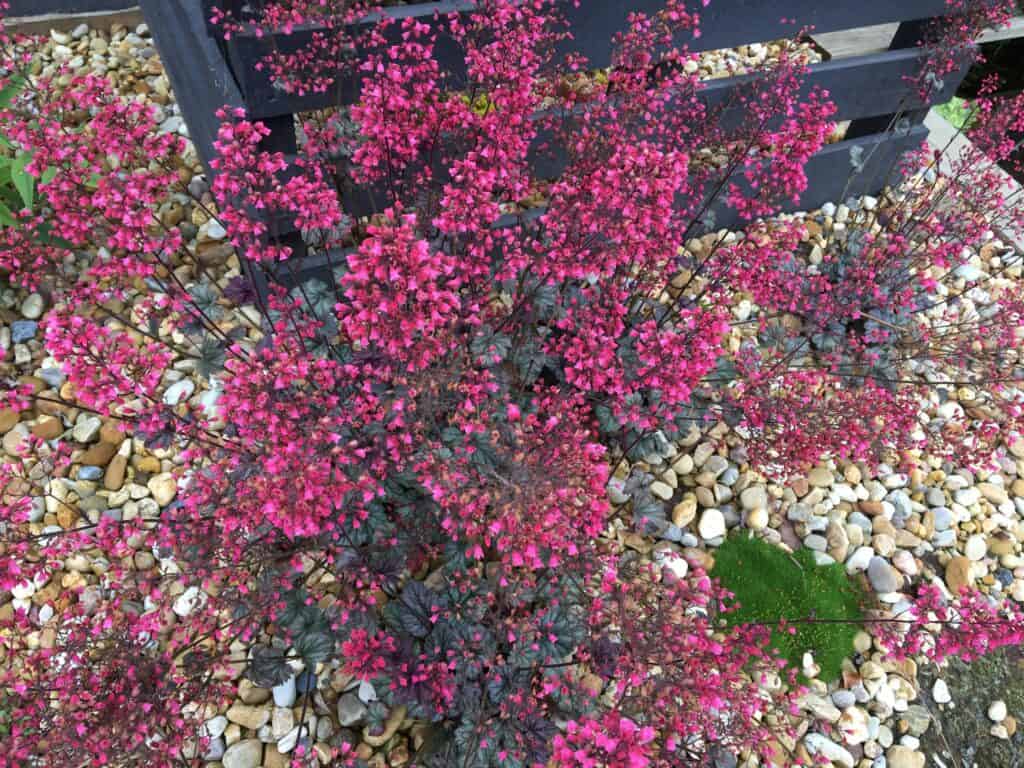
I cannot believe how long they flower for. They began in August (winter here in oz) and lasted until June (start of winter). But not only do they flower like mad, the foliage is soft and colourful in its own right.
As far as maintenance goes the only thing we do is remove the spent flowers a couple of times throughout the year.
Trachelospermum
Trachelopsermum (star jasmine) is an evergreen climber, but we also use it as a ground cover. Our personal favourite trachelospermum jasminoides tricolour we use as a small shrub. In the tropics it will grow as a trailing climber, but here in our temperate climate it becomes a small bush shrub.
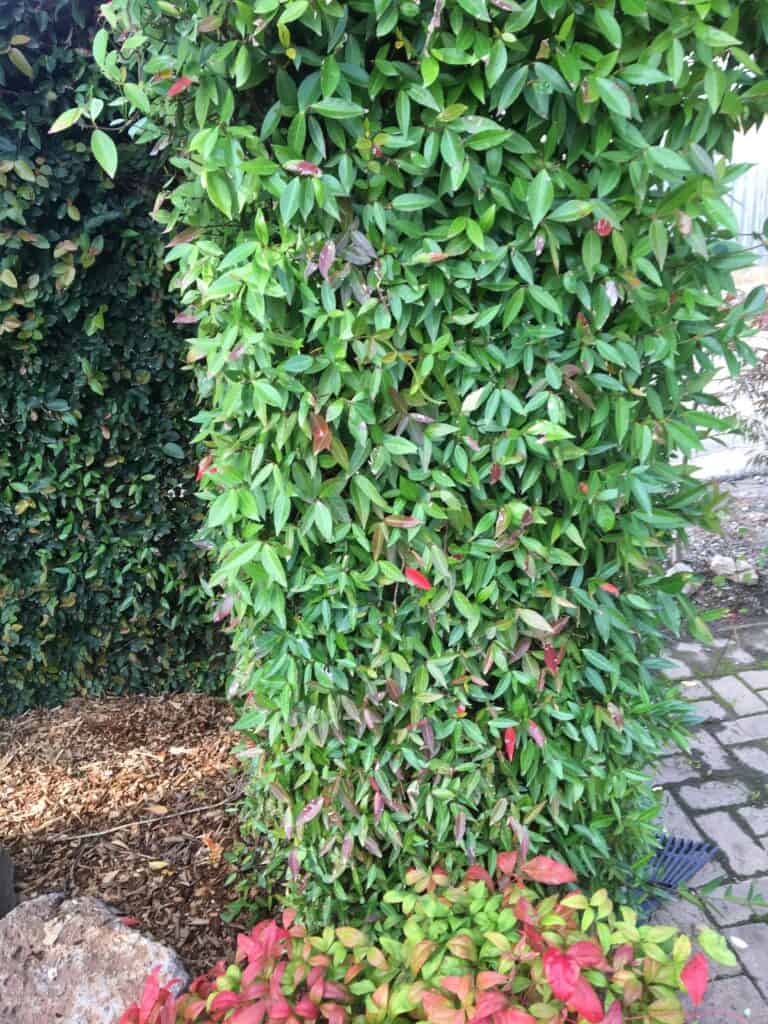
We also use trachelopermum asiaticum (Chinese star jasmine) this we have climbing over an arbor as you approach the house. The foliage being soft and evergreen make it perfect addition close to the house.
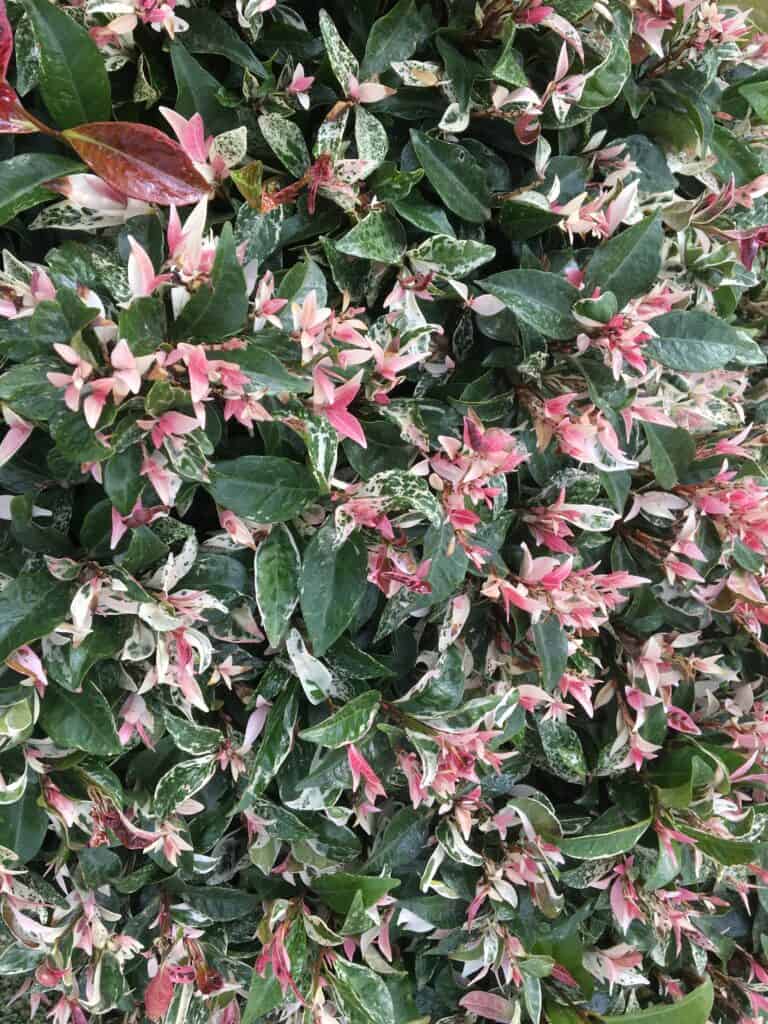
Trachelospermums aren’t fussy when it comes to light or soil conditions. Maintenance is a light prune whenever necessary.
Nandina
If you want a low maintenance, all year interest plant look no further than nandina domestica commonly known as sacred bamboo (even though it’s not a bamboo). There are three varieties we have incorporated in the gardens close to our house. Nandina domestica (tall growing), Nandina domestica ‘moonbay’ (medium growing) and Nandina domestica ‘nana’ (small growing).
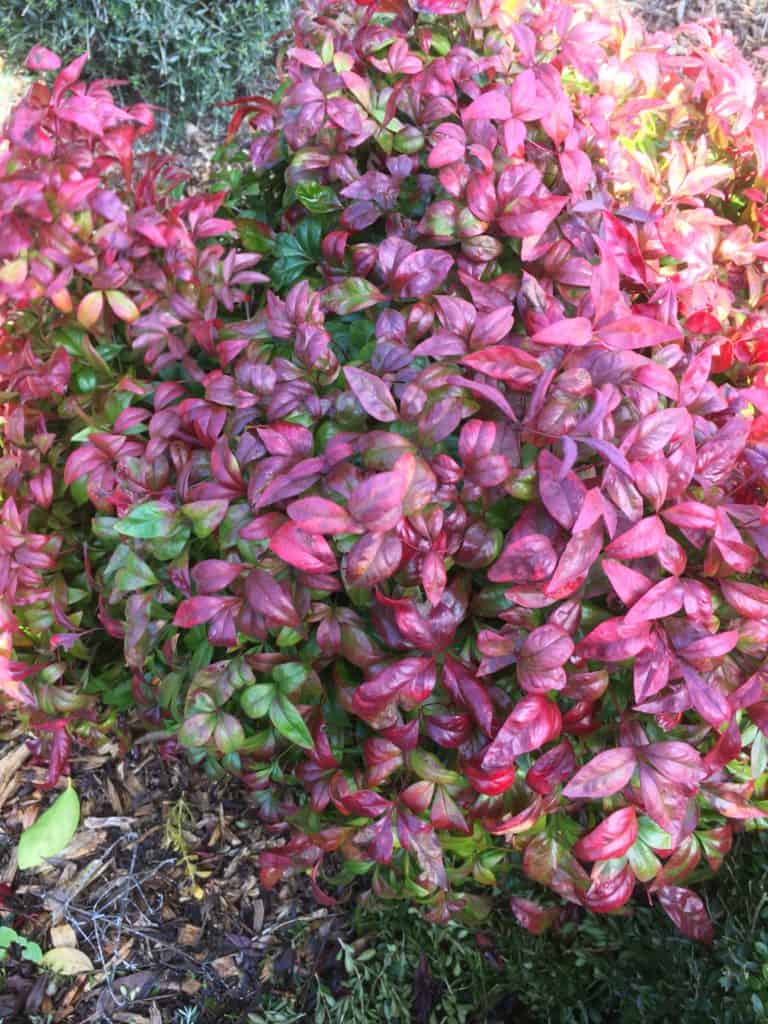
The foliage is constantly changing colours throughout the seasons. Lime/yellow in summer, Orange in autumn, Bright red in winter and multicoloured in spring.
Nandinas require as close to zero maintenance as a plant can have. Ours are never watered by us anyways and i think I’ve trimmed them 3 times in the past 10 years.
Acacia
Acacia is the botanical name for wattle. Now most wattles are totally unsuitable for planting near a house but one in-particular acacia cognata ‘mini cog’ is perfect for close to the house or pathways.
Mini cog has insignificant flowers, so insignificant you’ll never see them. The deep green, soft cascading foliage is what, it’s grown for. Min cog will grow to around a metre tall with a metre spread.
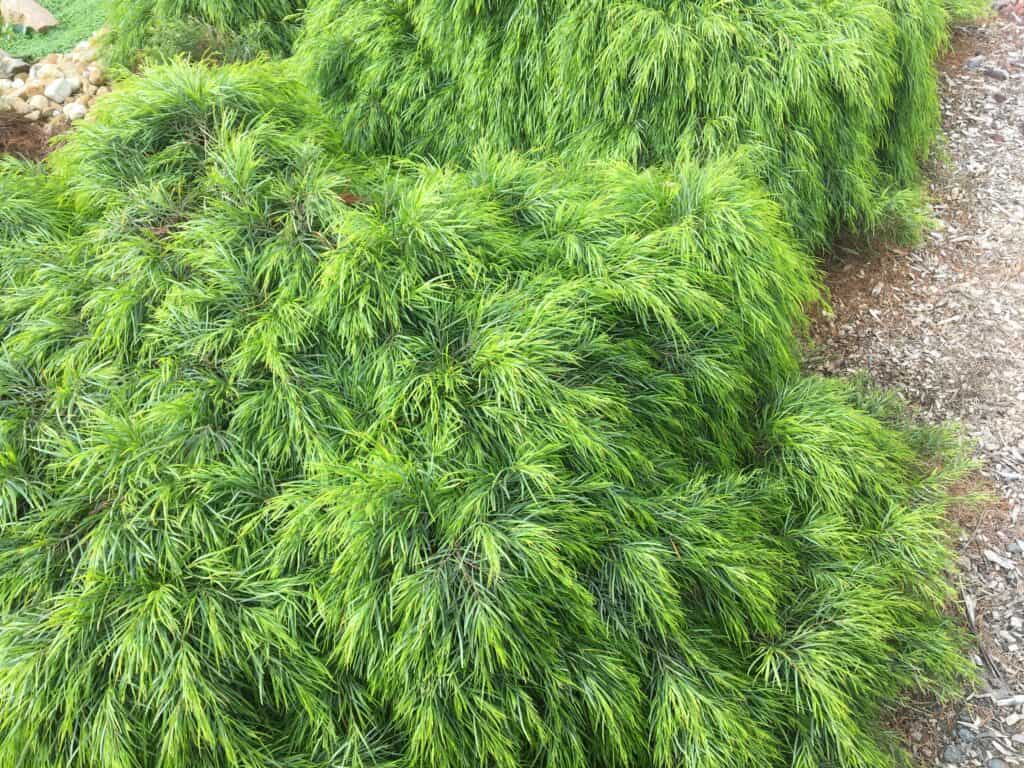
It does best in soils that hold moisture. We have found it doesn’t do particularly well in sandy soils. For those with sandy soils around the house try acacia cognata ‘green mist’. Acacia cognata’s can be pruned whenever needed.
There is a tree form called acacia cognata ‘lime magik’ and i love it when it’s young but it can spread quite large so therefore i don’t recommend it for close proximity to the house.
Strobilanthes
Strobilanthes sometimes known as persian shield is usually a tropical or indoor plant. However we have one that does great in our temperate climate. It’s called strobilanthes anisophyllus or goldfussia.
These are great little plants that have interesting foliage that changes from green to deep purple. The foliage is soft so again it can easily be planted near paths and driveways. It grows to about a metre high.
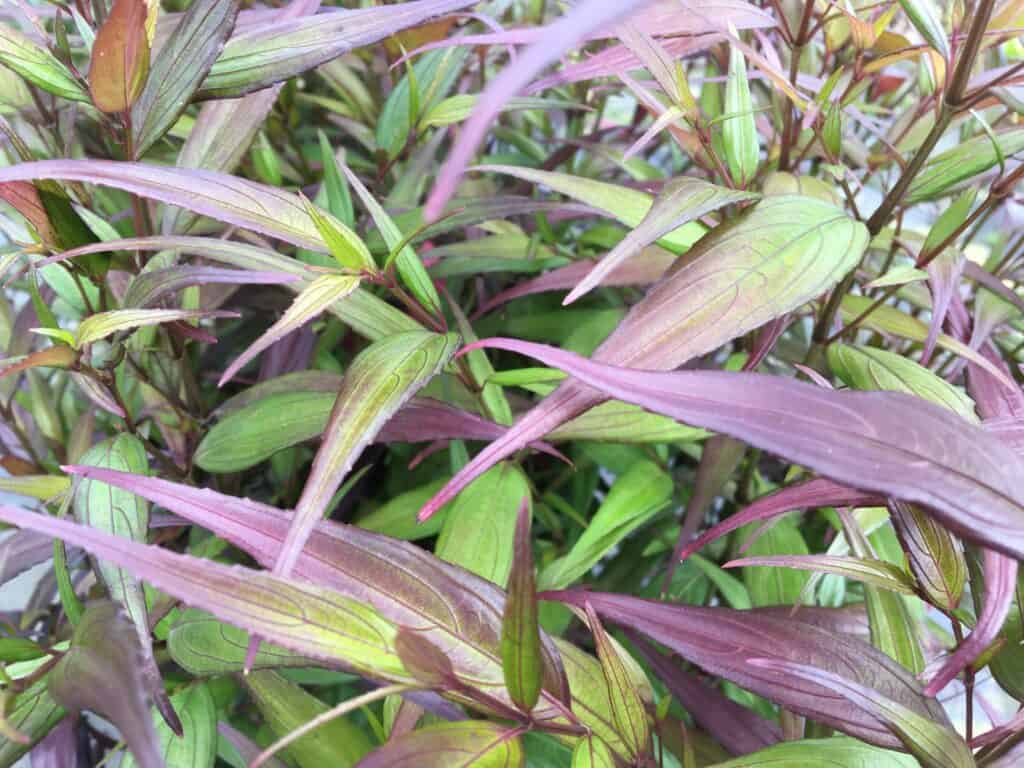
Goldfussia requires practically no maintenance and tolerates various soil conditions. It is sensitive to heavy frosts but can tolerate direct exposure to light frost. Plant in areas that are partly shaded.
It produces small trumpet shaped, mauve flowers but we these are quite small. We incorporate it in our gardens predominantly for its interesting foliage.
Ajuga
Ajugas are a great little ground cover. We use them as a living mulch. They grow fast, and as the leaves die they add organic material back into the soil.
It’s always good to have attractive carpeting plants to keep weeds at bay. We like to use ajuga reptens ‘purpurea’ or ‘jungle beauty’. Purpurea has deep purple foliage with mauve flowers, while jungle beauty has green foliage and mauve flowers.
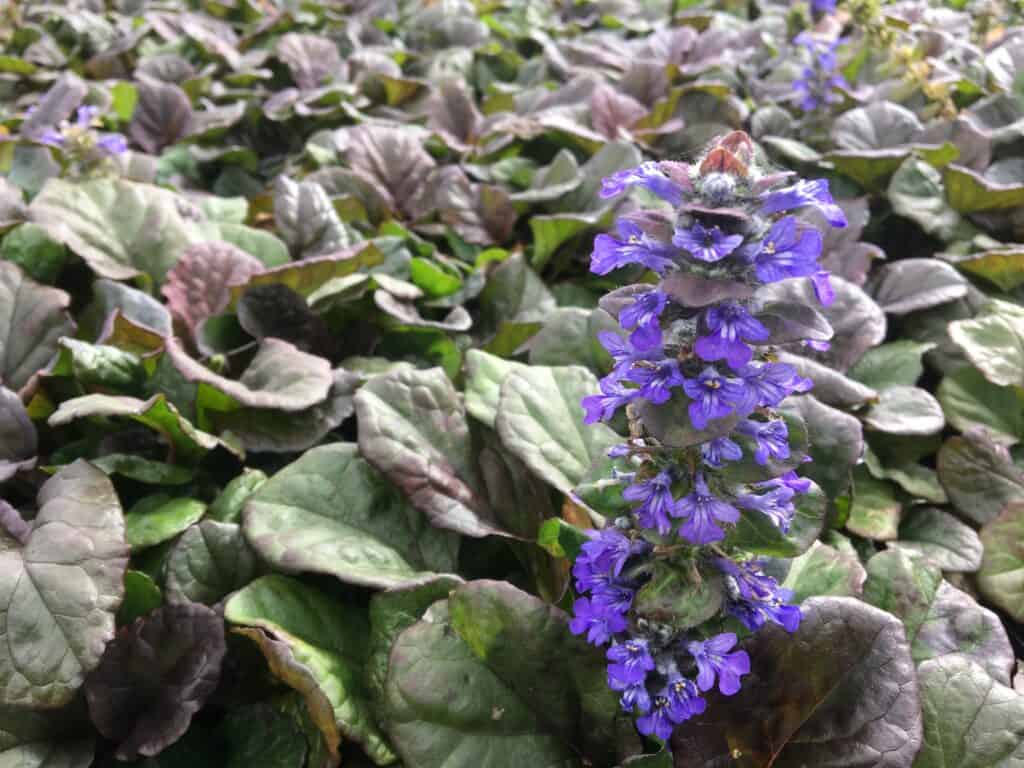
Ajugas are best planted under small trees and shrubs. Keep them away from other ground covers cause they will dominate them. They will from a nice thick carpet. They can be planted in full-sun but in our climate we plant them in shaded areas where they will receive some protection from frosts.
Box plants
Lastly is the trusty box hedge. Most people choose to use buxus sempervirens commonly known as English box. We much prefer buxus microphylla koreana know as Korean box. All the box hedges are suitable to be used in close proximity to the house.
The reason we prefer Korean box is that it doesn’t produce any unpleasant odours. There is a certain offensive odour to english box a different times of the year. I find it smells like cat piss! Thankfully Korean box doesn’t suffer from the same problem.
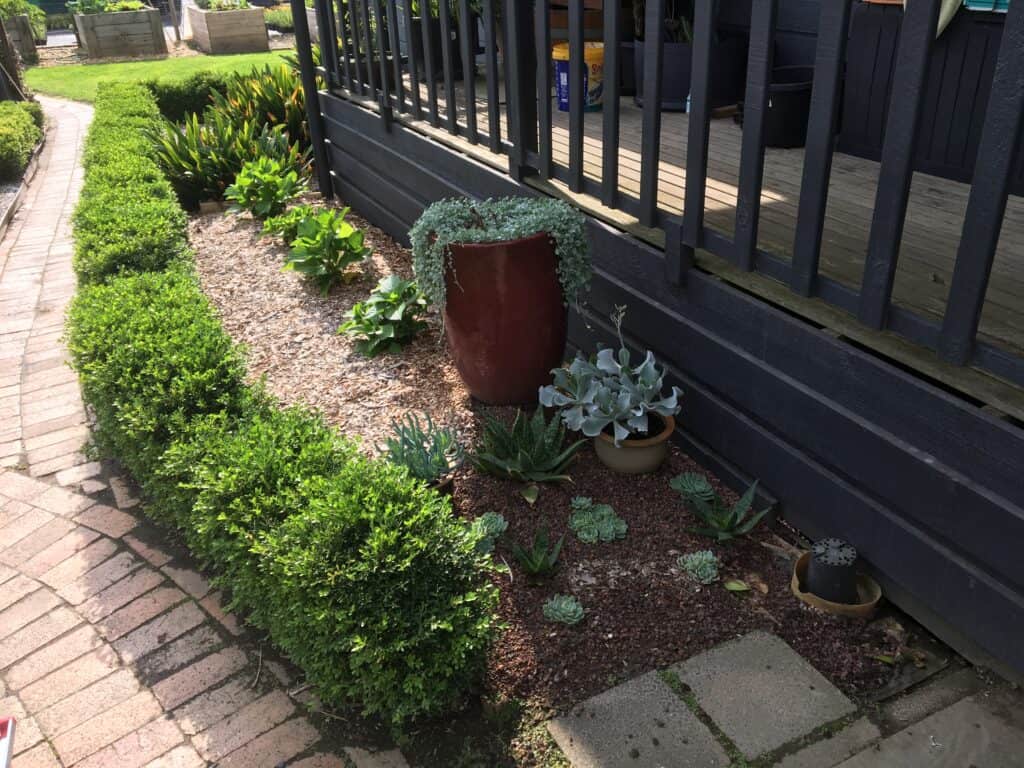
Korean box can be planted in full sun and part shade. It even does fairly well in proper shade, which is handy because other box hedges tend to go leggy in shaded areas.
All the commonly available boxwood plants are frost hardy and will grow in most soils. They are best pruned in late winter just before the new growth emerges. If its only a light prune you can do this anytime.
Create variation
You’ll notice that the plants we have close to our house all have varying heights from the Japanese maples and camellias ( which can grow to many metres), medium shrubs like hydrangeas and nandinas, small shrubs like strobilanthes, edging plants like heuchera and ground covers like sedum and ajuga.
When planning a garden close to the house incorporate plants of different sizes, shapes and colours. This will create an appealing landscape that is interesting on the eye. Even if you like formal styled gardens mix up the heights of the plantings.
Place larger trees or shrubs towards the back of the viewing area. Keep the lowered growing plants close to paths or areas where people will be viewing the garden.
Add pops of colour! That can either be with flowers or foliage. Mix it up so that everything doesn’t bloom all at once. Incorporate something for every season.
Hopefully some of the plants on this list, along with these couple of pointers will help you create a beautiful landscape right next to your home. Most of these plants we propagate ourselves and if you would like to try yourself check out our propagation page.
Thanks for reading and happy planting!
